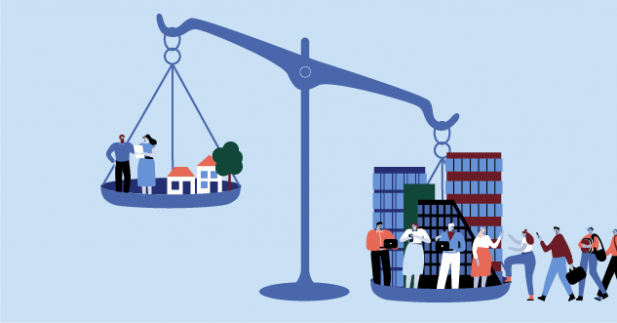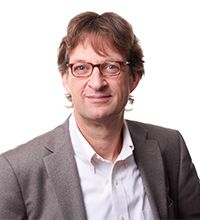City/Country: Why we expand unevenly

Do you live in the provinces or in Copenhagen? Are you a blacksmith or a consultant? Man or woman? Young or old?
Over the last few decades, the demographic development in Denmark has become a challenge, and we discuss whether the bigger cities experience too much growth compared to the smaller towns and villages. We also debate why things have developed in this manner. How can we stem the flow of young people, who leave rural areas to live in towns and cities. And whether it, by way of example, is a question of city life versus a lack of cultural offers in the provinces.
According to Peter Lotz, Associate Professor at Copenhagen Business School, the premises for this discussion are wrong. He conducts research on business and regional economy and fully acknowledges the need for discussions on cohesiveness and regional development in Denmark.
However, the discussions should then primarily focus on understanding the thick market.
THE THICK MARKET
“That is how the market forces work. We have to understand this, when we discuss a balanced Denmark.
Peter Lotz, Associate Professor
“The main reason for the growing imbalance between city and country is due to the development of our business structure. People simply move to areas where they can get work, and most companies are located in larger towns and cities. It is quite straight forward, really. Yet, it remains a highly underrated explanation,” Peter Lotz points out.
He adds that this type of development tends to become self-reinforcing. Because companies prefer to establish themselves in places that offer the largest qualified workforce. And wage earners want to live where there are more jobs to choose from. Both parties want to be in what Lotz calls “the thick labour market”.
“That is how the market forces work. We have to understand this, when we discuss a balanced Denmark. We can relocate public workplaces and support local education programmes in smaller towns, but it won’t affect the development,” Peter Lotz explains.
And according to him, the business sector has an increasing demand for a highly educated and skilled workforce, which is why they tend to look at the towns and cities, where they are more likely to find that workforce.
THE DEMAND FOR MANPOWER HAS CHANGED
Because it is no longer merely a question of factories that focus on production and workers in boiler suits.
Now, other activities are as if not even more important. Activities such as research and development, marketing, branding, green transition and lobbying. Even the daily running of companies requires special skills.
“Look at Mærsk. Today, it’s no longer a question of sailing a container ship from one harbour to the next. The assignments also include deep involvement in the construction of harbours, collaborations with on-land transportation and not least a meticulous managing and optimising of each individual container’s route,” Peter Lotz explains and then continues:
“The same is true when Ørsted wants to keep track of their windmills all over the world, and Novo Nordisk wants to manage their global production of insulin crystals. This requires specialised skillsets.”
And although Novo Nordisk now is planning to expand outside of Copenhagen, the traffic of workplaces has generally gone in the opposite direction.
BIGGER AND MORE SPECIALISED
“We’ve seen a similar development nationally. In the finance sector, they have closed down local branches and allocated special assignments to the main offices in Copenhagen. In fact, more than one in five jobs in the financial sector, outside the four largest cities, have disappeared between 2008 and 2021. On the other hand, larger towns and cities have seen an increase in the number of employed inhabitants, and more or less all of them are academics,” Peter Lotz recounts.
When the giant clothes retailer, Bestseller, from Brande, established a huge branch in Aarhus in 2015, it was also in order to gather the administrative jobs somewhere with a highly educated workforce.
“In addition to requiring special knowledge, being big has also become an important parameter. Fifty years ago, you had independent accountants in most larger provincial towns, but they are being ousted by national chains, who service the entire country from one or very few locations,” the CBS researcher adds.
The technological development as well as individual business structures have also lessened the need for local production facilities. In provincial towns, typical jobs are now in construction, commerce, transportation as well as tourism. And the difference in job offers in smaller and larger towns should also be viewed in terms of where we choose to live.
BIG GEOGRAPHICAL DIFFERENCES
Almost every other employee aged 30-34 in Copenhagen is an academic. And in case you are thinking that they jump on their bikes each morning and cycle to their public workplace: they do not. The majority work in private businesses.
It is a very different story in the south or west of Zealand, where no more than one in ten in the same age group will share self-experienced anecdotes from lectures they attended at university. In Eastern Jutland, where Aarhus constitutes a magnet, the number is one in four, which is also the national average. These numbers are from Statistics Denmark, 2020.
Apparently, the geographical development in the labour market also appeal differently to the sexes. At least according to Statistics Denmark, who informs us that the number of women in their twenties is higher than men in their twenties in the municipalities of Copenhagen, Frederiksberg, Hørsholm and Aarhus.
Whereas the number of men in their twenties is higher in all other municipalities. Perhaps because it is still primarily men who train as blacksmiths, carpenters and electricians.
TWO DIFFERENT SOCIETIES
“When almost half of the young people who enter the labour market in Copenhagen are academics, but the number is less than ten per cent in the south or west of Zealand, we have to divergent business structures and dynamics”
Peter Lotz, Associate Professor
“Now, we have a Copenhagen with a highly educated workforce and a business sector constantly demanding more. While the rest of the country has only a small highly educated workforce and a business sector that only slowly develops a demand for more,” Peter Lotz points out, before continuing:
“In some areas, we have become two quite different societies. When almost half of the young people who enter the labour market in Copenhagen are academics, but the number is less than ten per cent in the south or west of Zealand, we have to divergent business structures and dynamics.”
Peter Lotz emphasises that this difference does not necessarily say anything about income and consumerism. A 25-year-old apprentice carpenter in Ringsted or Ringkøbing may well make more money and have a lower mortgage or lower rent than a 30-year-old academic in Copenhagen.
INFRASTRUCTURE AND HOUSIN BECOME IMPORTANT
“Naturally, this is a development we have to address. Back in the 1970s, we had a regional development scheme, which resulted in a number of jobs in production. But this did not generate a permanent development dynamic in the local labour market, and now, the schemes are discontinued. I don’t believe that we can truly stop the closing down of workplaces in rural areas. It’s happening all over the world,” says Peter Lotz.
Which is why he is appealing to politicians to come up with some new tools. The regions should develop policies that would make the smaller towns more attractive to those who would like to exchange the pulse of the big city for greener and calmer surroundings. And in this, infrastructure and housing play a huge part.
“We should build more housing facilities and create better infrastructure, thus easing the commute. Now that working from home is becoming increasingly popular, it’s actually possible for a family of academics to move to a smaller town. However, they will want to be able to rent attractive housing, which makes settling somewhere new less of a risk. There will probably also be quite a few pensioners among the relocatees, and they will only be drawn in if there is attractive senior housing on offer,” according to Peter Lotz. He also points out that:
“There’s plenty of good life and good jobs outside the larger towns and cities. There just isn’t much growth. If we want to help the rural areas, we must acknowledge that they have to be something other than the towns and cities and then we must adjust our policies accordingly.”
